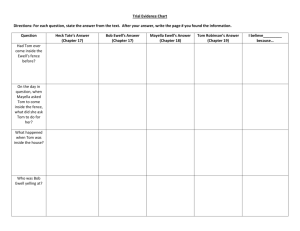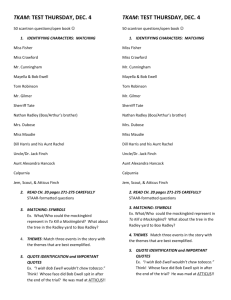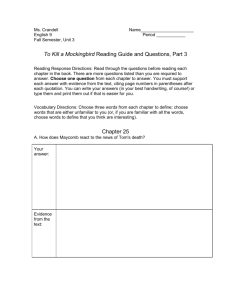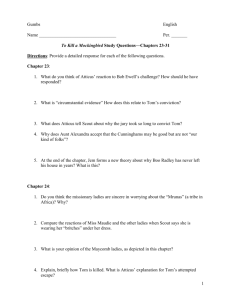In Franklin D. Roosevelt`s inaugural address, he makes a profound
advertisement
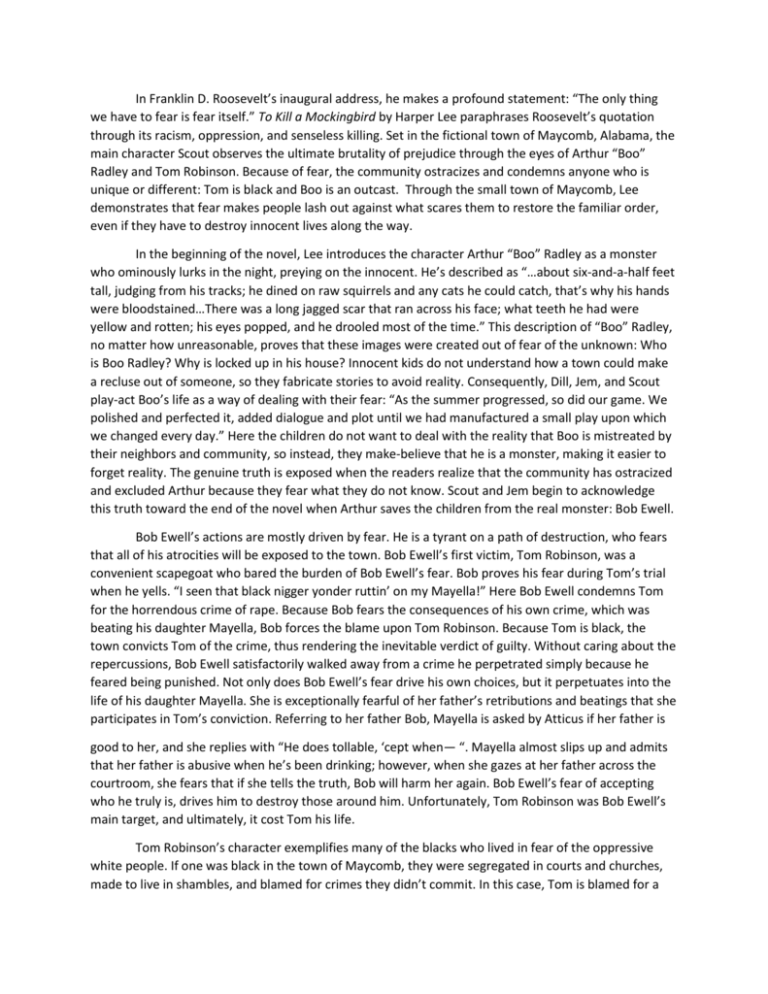
In Franklin D. Roosevelt’s inaugural address, he makes a profound statement: “The only thing we have to fear is fear itself.” To Kill a Mockingbird by Harper Lee paraphrases Roosevelt’s quotation through its racism, oppression, and senseless killing. Set in the fictional town of Maycomb, Alabama, the main character Scout observes the ultimate brutality of prejudice through the eyes of Arthur “Boo” Radley and Tom Robinson. Because of fear, the community ostracizes and condemns anyone who is unique or different: Tom is black and Boo is an outcast. Through the small town of Maycomb, Lee demonstrates that fear makes people lash out against what scares them to restore the familiar order, even if they have to destroy innocent lives along the way. In the beginning of the novel, Lee introduces the character Arthur “Boo” Radley as a monster who ominously lurks in the night, preying on the innocent. He’s described as “…about six-and-a-half feet tall, judging from his tracks; he dined on raw squirrels and any cats he could catch, that’s why his hands were bloodstained…There was a long jagged scar that ran across his face; what teeth he had were yellow and rotten; his eyes popped, and he drooled most of the time.” This description of “Boo” Radley, no matter how unreasonable, proves that these images were created out of fear of the unknown: Who is Boo Radley? Why is locked up in his house? Innocent kids do not understand how a town could make a recluse out of someone, so they fabricate stories to avoid reality. Consequently, Dill, Jem, and Scout play-act Boo’s life as a way of dealing with their fear: “As the summer progressed, so did our game. We polished and perfected it, added dialogue and plot until we had manufactured a small play upon which we changed every day.” Here the children do not want to deal with the reality that Boo is mistreated by their neighbors and community, so instead, they make-believe that he is a monster, making it easier to forget reality. The genuine truth is exposed when the readers realize that the community has ostracized and excluded Arthur because they fear what they do not know. Scout and Jem begin to acknowledge this truth toward the end of the novel when Arthur saves the children from the real monster: Bob Ewell. Bob Ewell’s actions are mostly driven by fear. He is a tyrant on a path of destruction, who fears that all of his atrocities will be exposed to the town. Bob Ewell’s first victim, Tom Robinson, was a convenient scapegoat who bared the burden of Bob Ewell’s fear. Bob proves his fear during Tom’s trial when he yells. “I seen that black nigger yonder ruttin’ on my Mayella!” Here Bob Ewell condemns Tom for the horrendous crime of rape. Because Bob fears the consequences of his own crime, which was beating his daughter Mayella, Bob forces the blame upon Tom Robinson. Because Tom is black, the town convicts Tom of the crime, thus rendering the inevitable verdict of guilty. Without caring about the repercussions, Bob Ewell satisfactorily walked away from a crime he perpetrated simply because he feared being punished. Not only does Bob Ewell’s fear drive his own choices, but it perpetuates into the life of his daughter Mayella. She is exceptionally fearful of her father’s retributions and beatings that she participates in Tom’s conviction. Referring to her father Bob, Mayella is asked by Atticus if her father is good to her, and she replies with “He does tollable, ‘cept when— “. Mayella almost slips up and admits that her father is abusive when he’s been drinking; however, when she gazes at her father across the courtroom, she fears that if she tells the truth, Bob will harm her again. Bob Ewell’s fear of accepting who he truly is, drives him to destroy those around him. Unfortunately, Tom Robinson was Bob Ewell’s main target, and ultimately, it cost Tom his life. Tom Robinson’s character exemplifies many of the blacks who lived in fear of the oppressive white people. If one was black in the town of Maycomb, they were segregated in courts and churches, made to live in shambles, and blamed for crimes they didn’t commit. In this case, Tom is blamed for a white man’s (Bob Ewell’s) child-abuse crime. Mr. Gilmer, the prosecutor, asks Tom a few questions regarding the day Tom helped Mayella with one of her chores: "But you weren't in a fix—you testified that you were resisting Miss Ewell. Were you so scared that she'd hurt you, you ran, a big buck like you?" "No suh, I's scared I'd be in court, just like I am now." "Scared of arrest, scared you'd have to face up to what you did?" "No suh, scared I'd hafta face up to what I didn't do. (Lee 141) It is clear here that Tom Robinson ran from the Ewell’s residence out of fear, not the fear of being caught but the fear of being blamed for a crime he did not commit. By the end of the trial, fear had encumbered Tom Robinson so much that he chose to put an end to his life. After his conviction, Tom felt that an escape from prison was his only way out. “Calpurnia said Atticus told her that the day they took Tom to prison he just gave up hope.” If one gives up hope, fear has overcome him, and at this point in the novel, Tom had let his fear supersede his sense of hope. Tom feared that the white people in the town of Maycomb were going to forever take his power away. Instead of allowing white people to control him, Tom Robinson fled the prison and left there with 17 bullet holes in him. Prejudice evokes an unavoidable fear, especially when the ones who are prejudice are the majority. Harper Lee creates the characters of Arthur “Boo” Radley, Bob Ewell, and Tom Robinson to explore the concept of fear, thus exemplifying the theme that fear drives people to act and behave in a destructive manner, simply so they can keep order in their lives. By examining the behavior of the community and characters in the novel, we understand that fear can produce the destruction of lives. If fear incapacitates our logic, we are left with hopelessness. As readers, we can learn from Lee’s novel that fear should not be the driver of our lives. We must learn to fear only fear itself.
